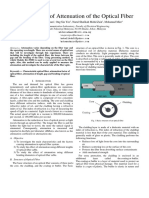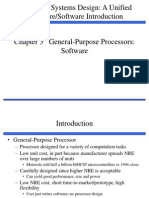100%(1)100% found this document useful (1 vote)
72 viewsArray Processor
An array processor performs computations on large arrays of data in parallel. It contains multiple arithmetic logic units (ALUs) that allow all array elements to be processed simultaneously. There are two main types: attached array processors connect to general purpose computers to improve performance for numeric tasks, while SIMD (Single Instruction Multiple Data) array processors contain identical processing elements that perform the same operation synchronously under a control unit. Array processors are used to enhance computational speed for applications such as medical imaging, speech processing, and signal analysis.
Uploaded by
venmathimsc482Copyright
© © All Rights Reserved
Available Formats
Download as DOCX, PDF, TXT or read online on Scribd
100%(1)100% found this document useful (1 vote)
72 viewsArray Processor
An array processor performs computations on large arrays of data in parallel. It contains multiple arithmetic logic units (ALUs) that allow all array elements to be processed simultaneously. There are two main types: attached array processors connect to general purpose computers to improve performance for numeric tasks, while SIMD (Single Instruction Multiple Data) array processors contain identical processing elements that perform the same operation synchronously under a control unit. Array processors are used to enhance computational speed for applications such as medical imaging, speech processing, and signal analysis.
Uploaded by
venmathimsc482Copyright
© © All Rights Reserved
Available Formats
Download as DOCX, PDF, TXT or read online on Scribd
You are on page 1/ 8
Array Processor:
A supercomputer is a very powerful computer that includes
architecture, resources & components that gives a huge
computing power to the consumer. A supercomputer also
contains a large number of processors which performs millions or
billions of computations each second. So these computers can
perform numerous tasks in a few seconds.
There are three types of supercomputers tightly connected
cluster computers that work together like a single unit. Commodity
computers can connect to low latency & high-bandwidth LANs
and finally vector processing computers which depend on an
array processor or vectors. An array processor is like a CPU that
helps in performing mathematical operations on various data
elements. The most famous array processor is the ILLIAC IV
computer which is designed by the Burroughs Corporation. This
article discusses an overview of an array processor – working,
types & applications.
What is Array Processor?
A processor which is used to perform different computations on a
huge array of data is called an array processor. The other terms
used for this processor are vector processors or multiprocessors.
This processor performs only single instruction at a time on an
array of data. These processors work with huge data sets to
execute computations. So, they are mainly used for enhancing
the performance of computers.
Array Processor Architecture
An array processor includes a number of ALUs (Arithmetic Logic
Units) which allows all the array elements to be processed
together. Each ALU in the processor is provided with local
memory which is known as a Processing Element or PE. The
architecture of this processor is shown below. By using this
processor, a single instruction is issued through a control unit &
that instruction is simply applied to a number of data sets
simultaneously. By using a single instruction, a similar operation
is performed on an array of data which makes it suitable for vector
computations.
Array Processor Architecture
The array processing architecture is known as a 2-dimensional
array or matrix. This architecture is implemented by the two-
dimensional processor. In this processor, the CPU issues a single
instruction & after that, it is applied to a no. of data
simultaneously. This architecture mainly depends on the fact that
all data sets work on similar instructions, however, if these data
sets are reliant on each other, it is not achievable to apply parallel
processing. Thus these processors contribute efficiently &
enhance the processing speed as compared to the whole
instructions.
Working of Array Processor
An array processor has an architecture mainly designed for
processing arrays of numbers. This processor architecture
contains a number of processors that works simultaneously, each
handling one array element, so that a single operation is applied
to all the array elements in parallel. To get the same effect within
a conventional processor, the operation should be applied to
every array element sequentially and much more slowly.
This processor is a self-contained unit connected to the main
computer through an internal bus or an I/O port. This processor
increases the overall speed of instruction processing. These
processors operate asynchronously from the host CPU to improve
the overall system capacity. This processor is a very powerful tool
that handles troubles with a high level of parallelism.
Types of Array Processor
There are two types of array processor like; attached and SIMD
which is discussed below.
Attached Array Processor
The auxiliary processor like the attached array processor is
shown below. This processor is simply connected to a computer
for enhancing the performance of a machine within numerical
computational tasks. This processor is connected to the General
Purpose Computer through an I/O interface and a local memory
interface where both the memories like the main & the local are
connected. This processor achieves high performance through
parallel processing by multiple functional units.
Attached Array Processor
SIMD Array Processor
SIMD (‘Single Instruction and Multiple Data Stream’)
processors is a computers with several processing units which
operate in parallel. These processing units perform the same
operation in synchronizing under the supervision of the common
control unit (CCU). The SIMD processor includes a set of identical
PEs (processing elements) where each PES has a local memory.
SIMD Array Processor
This processor includes a master control unit and main
memory. The master control unit in the processor controls the
operation of the processing elements. And also, decodes the
instruction & determines how the instruction is executed. So, if the
instruction is program control or scalar then it is executed directly
in the master control unit. Main memory is mainly used to store
the program while every processing unit uses operands that are
stored in its local memory.
SIMD describes computers with multiple processing
elements that perform the same operation on multiple data points
simultaneously.
Advantages
The advantages of an array processor include the following.
*Array processors improve the whole instruction processing
speed.
These processors run asynchronously from the host CPU the
overall capacity of the system is improved.
These processors include their own local memory that provides
extra memory to systems. So this is an important consideration
for the systems through a limited address space or physical
memory.
These processors simply perform computations on a huge
array of data.
These are extremely powerful tools that help in handling
troubles with a high amount of parallelism.
This processor includes a number of ALUs that permits all the
array elements to be processed simultaneously.
Generally, the I/O devices of this processor-array system are
very efficient in supplying the required data to the memory
directly.
The main advantage of using this processor with a range of
sensors is a slighter footprint.
Applications
The applications of array processors include the following.
This processor is used in medical and astronomy applications.
These are very helpful in speech improvement.
These are used in sonar and radar systems.
These are applicable in anti-jamming, seismic exploration
& wireless communication.
This processor is connected to a general-purpose computer to
improve the computer’s performance within arithmetic
computational tasks. So it attains high performance through
parallel processing by several functional units.
A processor that performs computations on a vast array of data is
known as an array processor. Multiprocessors and vector processors are
other terms for array processors. It only executes one instruction at a
time on an array of data. They work with massive data sets to perform
computations.
Array processors are also known as multiprocessors or vector
processors. They perform computations on large arrays of data. Thus,
they are used to improve the performance of the computer.
Array Processor performs computations on large array of data.
These are two types of Array Processors: Attached Array Processor, and
SIMD Array Processor.
SIMD represents single-instruction multiple-data streams. The SIMD
model of parallel computing includes two parts such as a front-end
computer of the usual von Neumann style, and a processor array as
displayed
In computing, a vector processor or array processor is a central
processing unit (CPU) that implements an instruction set where its
instructions are designed to operate efficiently and effectively on large
one-dimensional arrays of data called vectors.
The difference between an array processor and a vector processor
is that a vector processor uses multiple vector pipelines whereas an array
processor employs a number of processing elements to operate in
parallel.
For example, when attached to a VAX 11 computer, the
FSP-164/MAX from Floating-Point Systems increases the
computing power of the VAX to 100megaflops. The objective of
the attached array processor is to provide vector manipulation
capabilities to a conventional computer at a fraction of the cost of
supercomputer.
You might also like
- Instruction Format: Performed. Register. Effective Address of The Operand Is To Be Found OutNo ratings yetInstruction Format: Performed. Register. Effective Address of The Operand Is To Be Found Out3 pages
- Unit - 5 Computer Arithmetic: 5.1 Addition and SubtractionNo ratings yetUnit - 5 Computer Arithmetic: 5.1 Addition and Subtraction16 pages
- Instruction Formats: Each Instruction Consists of Two PartsNo ratings yetInstruction Formats: Each Instruction Consists of Two Parts15 pages
- Comparison of Cryptography Algorithms in BlockchainNo ratings yetComparison of Cryptography Algorithms in Blockchain6 pages
- 8 Complex Systems & Microprocessors Part IINo ratings yet8 Complex Systems & Microprocessors Part II17 pages
- Measurement of The Attenuation of The OpNo ratings yetMeasurement of The Attenuation of The Op9 pages
- BM6712 Digital Image Processing LaboratoryNo ratings yetBM6712 Digital Image Processing Laboratory61 pages
- Lab Manual # 03 Implementation of Flag Registers100% (1)Lab Manual # 03 Implementation of Flag Registers4 pages
- Register Transfer Language and Register TransferNo ratings yetRegister Transfer Language and Register Transfer11 pages
- Hydraulic and Pneumatic Actuators and Their ApplicationNo ratings yetHydraulic and Pneumatic Actuators and Their Application24 pages
- Organization of The 8086/8088 Microprocessor: Lecture#6No ratings yetOrganization of The 8086/8088 Microprocessor: Lecture#619 pages
- Operation of Amplification, Filtering, Sample and Hold CircuitsNo ratings yetOperation of Amplification, Filtering, Sample and Hold Circuits6 pages
- Telerobotics: by Amaren P Das So-E, DRHR, BarcNo ratings yetTelerobotics: by Amaren P Das So-E, DRHR, Barc26 pages
- ITT430 - Topic 1 - Introduction To Microcomputer (20202)No ratings yetITT430 - Topic 1 - Introduction To Microcomputer (20202)2 pages
- Operating Systems Interview Questions You'll Most Likely Be AskedFrom EverandOperating Systems Interview Questions You'll Most Likely Be AskedNo ratings yet
- Third Year Sixth Semester CS6601 Distributed System 2 Mark With Answer86% (7)Third Year Sixth Semester CS6601 Distributed System 2 Mark With Answer25 pages
- CS 542: Topics in Distributed Systems: Transactions and Concurrency ControlNo ratings yetCS 542: Topics in Distributed Systems: Transactions and Concurrency Control46 pages
- Concurrency On Operating System: Platform TechnologyNo ratings yetConcurrency On Operating System: Platform Technology21 pages
- Operating System Kcs-401. Question Bank À Unit-Iii: Cpu Scheduling and DeadlocksNo ratings yetOperating System Kcs-401. Question Bank À Unit-Iii: Cpu Scheduling and Deadlocks4 pages
- DTHREADS - Efficient and Deterministic MultithreadingNo ratings yetDTHREADS - Efficient and Deterministic Multithreading10 pages
- Leader Election in Rings - O (n2) Algorithm, Bully AlgorithmNo ratings yetLeader Election in Rings - O (n2) Algorithm, Bully Algorithm40 pages
- CS2255 Data Base Management Systems Question BankNo ratings yetCS2255 Data Base Management Systems Question Bank2 pages
- Unit-Iii Distributed Objects and Remote InvocationNo ratings yetUnit-Iii Distributed Objects and Remote Invocation12 pages
- @KLWKS_BOT OS EXP - 9 (R) MODE WORKBOOK ANSWER_THANOS_No ratings yet@KLWKS_BOT OS EXP - 9 (R) MODE WORKBOOK ANSWER_THANOS_14 pages
- 16 Questions For Practice On SchedulingNo ratings yet16 Questions For Practice On Scheduling20 pages
- Instruction Format: Performed. Register. Effective Address of The Operand Is To Be Found OutInstruction Format: Performed. Register. Effective Address of The Operand Is To Be Found Out
- Unit - 5 Computer Arithmetic: 5.1 Addition and SubtractionUnit - 5 Computer Arithmetic: 5.1 Addition and Subtraction
- Instruction Formats: Each Instruction Consists of Two PartsInstruction Formats: Each Instruction Consists of Two Parts
- Comparison of Cryptography Algorithms in BlockchainComparison of Cryptography Algorithms in Blockchain
- Hydraulic and Pneumatic Actuators and Their ApplicationHydraulic and Pneumatic Actuators and Their Application
- Organization of The 8086/8088 Microprocessor: Lecture#6Organization of The 8086/8088 Microprocessor: Lecture#6
- Operation of Amplification, Filtering, Sample and Hold CircuitsOperation of Amplification, Filtering, Sample and Hold Circuits
- ITT430 - Topic 1 - Introduction To Microcomputer (20202)ITT430 - Topic 1 - Introduction To Microcomputer (20202)
- Operating Systems Interview Questions You'll Most Likely Be AskedFrom EverandOperating Systems Interview Questions You'll Most Likely Be Asked
- Third Year Sixth Semester CS6601 Distributed System 2 Mark With AnswerThird Year Sixth Semester CS6601 Distributed System 2 Mark With Answer
- CS 542: Topics in Distributed Systems: Transactions and Concurrency ControlCS 542: Topics in Distributed Systems: Transactions and Concurrency Control
- Concurrency On Operating System: Platform TechnologyConcurrency On Operating System: Platform Technology
- Operating System Kcs-401. Question Bank À Unit-Iii: Cpu Scheduling and DeadlocksOperating System Kcs-401. Question Bank À Unit-Iii: Cpu Scheduling and Deadlocks
- DTHREADS - Efficient and Deterministic MultithreadingDTHREADS - Efficient and Deterministic Multithreading
- Leader Election in Rings - O (n2) Algorithm, Bully AlgorithmLeader Election in Rings - O (n2) Algorithm, Bully Algorithm
- Unit-Iii Distributed Objects and Remote InvocationUnit-Iii Distributed Objects and Remote Invocation
- @KLWKS_BOT OS EXP - 9 (R) MODE WORKBOOK ANSWER_THANOS_@KLWKS_BOT OS EXP - 9 (R) MODE WORKBOOK ANSWER_THANOS_

























































































